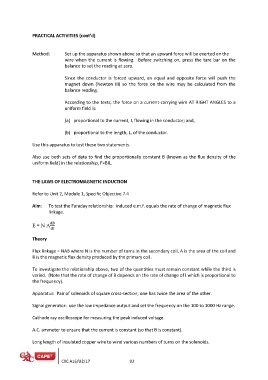Page 593 - SUBSEC October 2017_Neat
P. 593
PRACTICAL ACTIVITIES (cont’d)
Method: Set up the apparatus shown above so that an upward force will be exerted on the
wire when the current is flowing. Before switching on, press the tare bar on the
balance to set the reading at zero.
Since the conductor is forced upward, an equal and opposite force will push the
magnet down (Newton III) so the force on the wire may be calculated from the
balance reading.
According to the texts, the force on a current-carrying wire AT RIGHT ANGLES to a
uniform field is:
(a) proportional to the current, I, flowing in the conductor; and,
(b) proportional to the length, L, of the conductor.
Use this apparatus to test these two statements.
Also use both sets of data to find the proportionally constant B (known as the flux density of the
uniform field) in the relationship, F=BIL.
THE LAWS OF ELECTROMAGNETIC INDUCTION
Refer to Unit 2, Module 1, Specific Objective 7.4
Aim: To test the Faraday relationship: induced e.m.f. equals the rate of change of magnetic flux
linkage.
dB
E = N A
dt
Theory
Flux linkage = NAB where N is the number of turns in the secondary coil, A is the area of the coil and
B is the magnetic flux density produced by the primary coil.
To investigate the relationship above, two of the quantities must remain constant while the third is
varied. (Note that the rate of change of B depends on the rate of change of I which is proportional to
the frequency).
Apparatus: Pair of solenoids of square cross-section; one has twice the area of the other.
Signal generator: use the low impedance output and set the frequency on the 100 to 1000 Hz range.
Cathode ray oscilloscope for measuring the peak induced voltage.
A.C. ammeter to ensure that the current is constant (so that B is constant).
Long length of insulated copper wire to wind various numbers of turns on the solenoids.
CXC A16/U2/17 93

